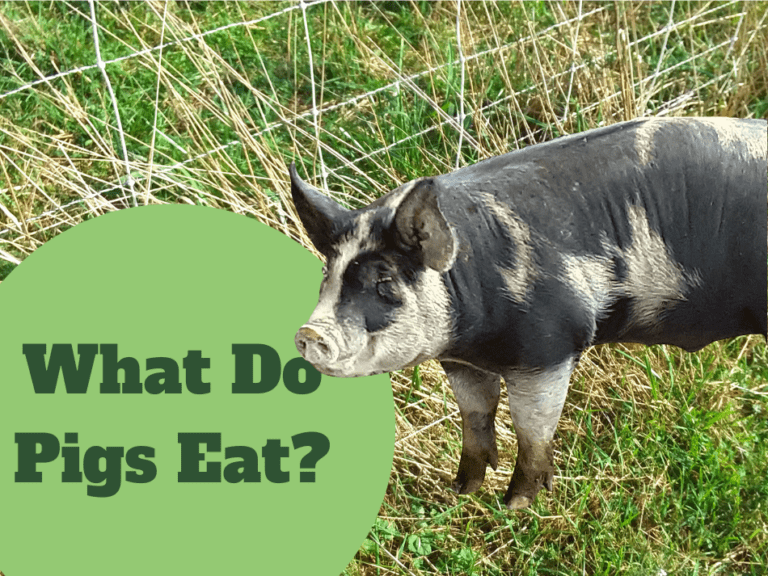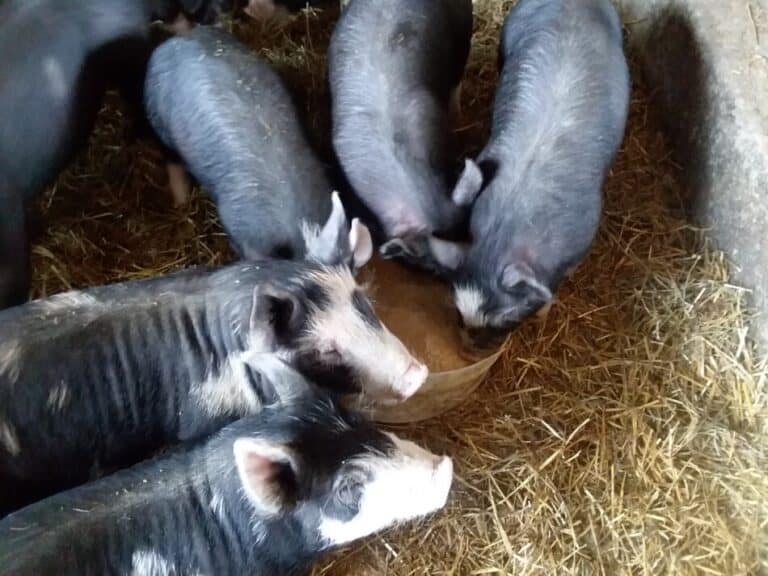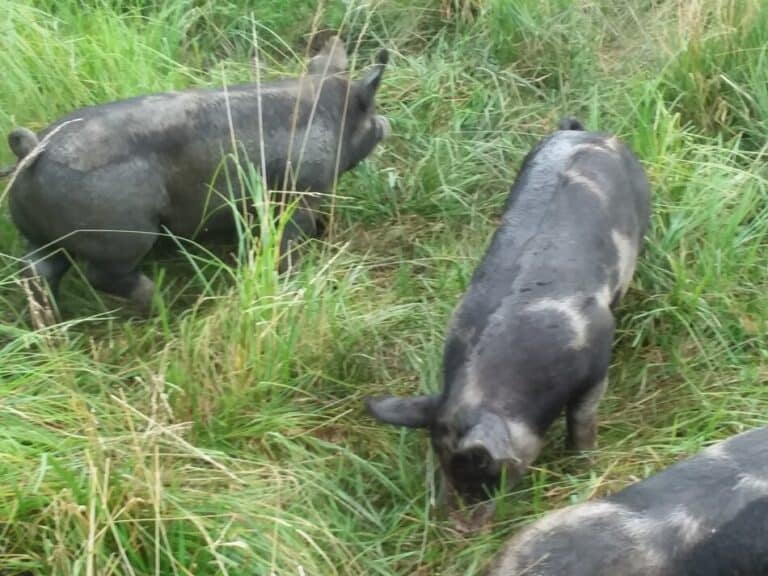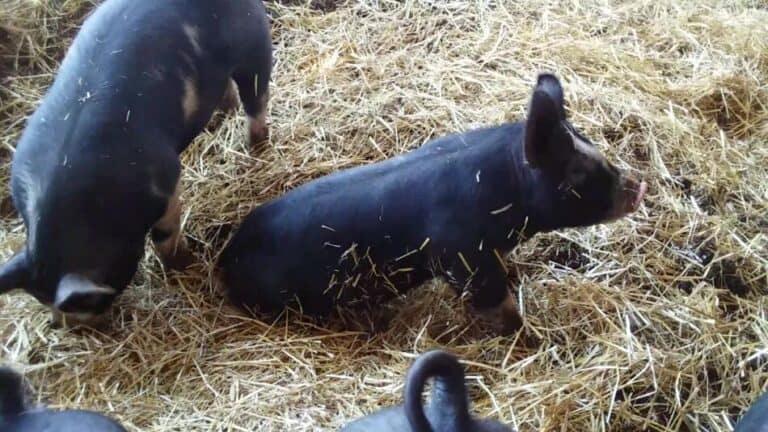Pounds Of Feed Needed To Raise A Pig For Meat
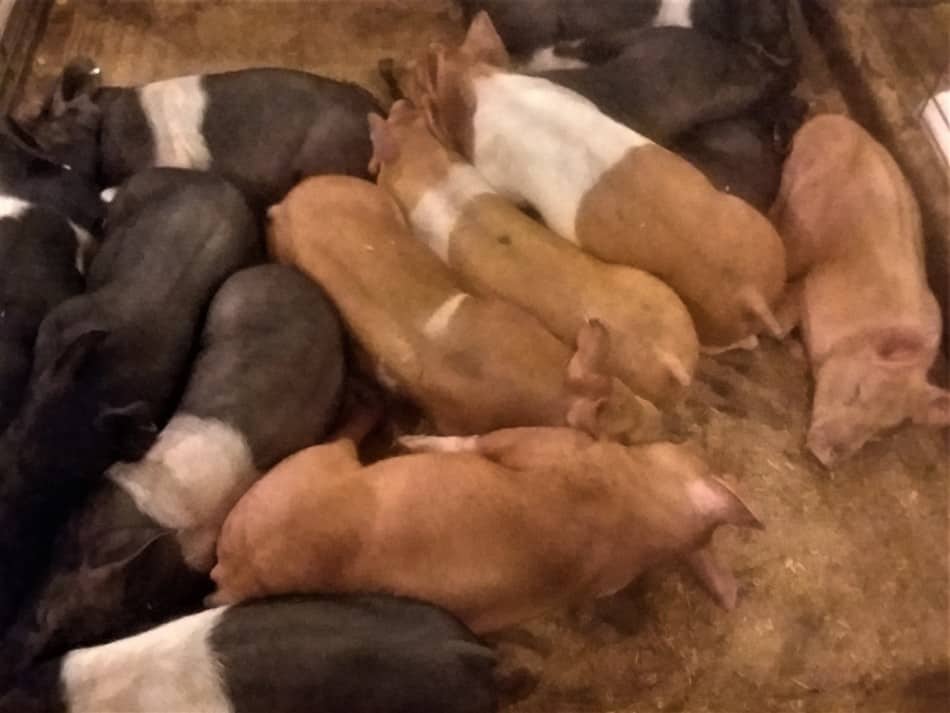
Ready to get some feeder pigs? Whether you’re looking to be more self sufficient or just want some great tasting meat for the freezer, pigs are a great place to get started!
Now the main question: How much feed is this pig going to need?
Feeder pigs need 600-700 pounds of feed per pig to reach 260 pounds live weight. Raising pigs to 300+ pounds of live weight will require an additional 200 pounds (or more) of feed, increasing the total feed needed per pig a minimum of 900 pounds.
The pounds of feed your pigs are going to need is actually pretty easy to figure out, no need to worry. We’ll go through some examples below.
Is Raising Your Own Pigs For Meat Worth It? will go over a budget for buying, feeding, caring for and butchering your pigs.
When Is Your Pig Is Ready To Butcher? will show you the things to look for with your pigs to know if they are well grown, have great fat cover and are ready for the freezer.
| Size of feeder pig (pig you start with) | 260 pound pig (target weight for processing) | 300+ pound pig (target weight for processing) |
| 35 pound pig | 675 pounds feed | 875+ pounds of feed |
| 60 pound pig | 600 pounds feed | 800+ pounds of feed |
Note: There are a few things that can have reality messing up your calculations, like crazy hot weather, an usually thin or active feeder pig or if your feeder have worms!
Overall, these feed estimates are reliable numbers to use to make your plans and budget.
700 pounds of feed needed per pig
You’ll need 600-700 pounds of feed per pig to grow them from feeder pig size to finishing weight.
Variables that will affect the pounds of feed you will need:
- Size of feeder pig you start with
- Time of the year you are raising the pigs
- Amount of exercise the pigs get
- Genetics of the feeder pig
- How much feed they can waste
Size of feeder pig determines feed needed
Smaller feeder pigs will take more feed to get them to finishing size than if you were to start with a bigger feeder pig.
For example: starting with a 60 pound feeder pig means your pig needs to gain 200 pounds of body weight to reach a finishing weight of 260.
260-60=200 pounds of gain needed
If you start with a 35 pound feeder pig it will need to gain an additional 25 pounds to reach the same finishing weight.
260-35=225 pounds of gain needed
Pigs need 3 pounds of feed for every pound of gain. To get the total feed take pounds of gain needed per pig x 3=total pounds of feed
60 pound feeder: 200 pounds needed x 3=600 pounds of feed for the pig
35 pound feeder: 225 pounds needed x 3=675 pounds of feed for the pig
Starting with a smaller size feeder pig is not a problem, it will just take more time and more feed.
9 Things You Should Know When Raising Pigs For Meat will give you an overview of the things you need to have figured out to successfully raise your pigs.
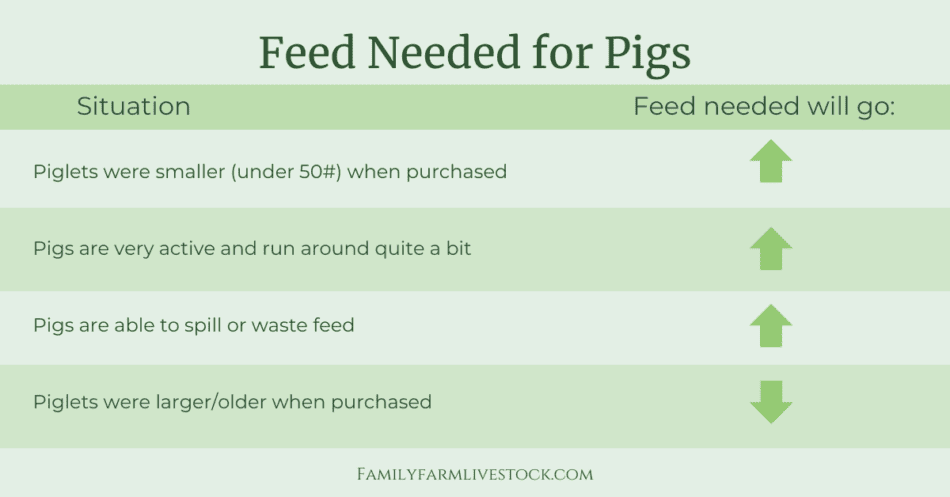
A note on buying feeder pigs at an auction
The pigs pictured for this article are all from the Kidron Auction in Kidron, Ohio. Be sure to attend if you can, it’s a great feeder pig sale.
I enjoy just looking around, whether I’m wanting to buy something or not.
As with all livestock auctions, should you decide to bid on feeder pigs, you are bidding per pig times all the pigs in the group.
As an example: in a group of 12 pigs that sell for $55.00 each, that group of pigs will cost $660.00 (12 x 55)
Need just a few pigs? Choose a smaller group to bid on or as at the office before the sale. Sometimes, you will be allowed pick a few out of the group.
Be sure to ask before the sale and know that it will cost quite a bit more per pig than the selling price per pig if you would take the whole group.
Buying Livestock At Auctions goes over the things you need to know before your buy your pigs.
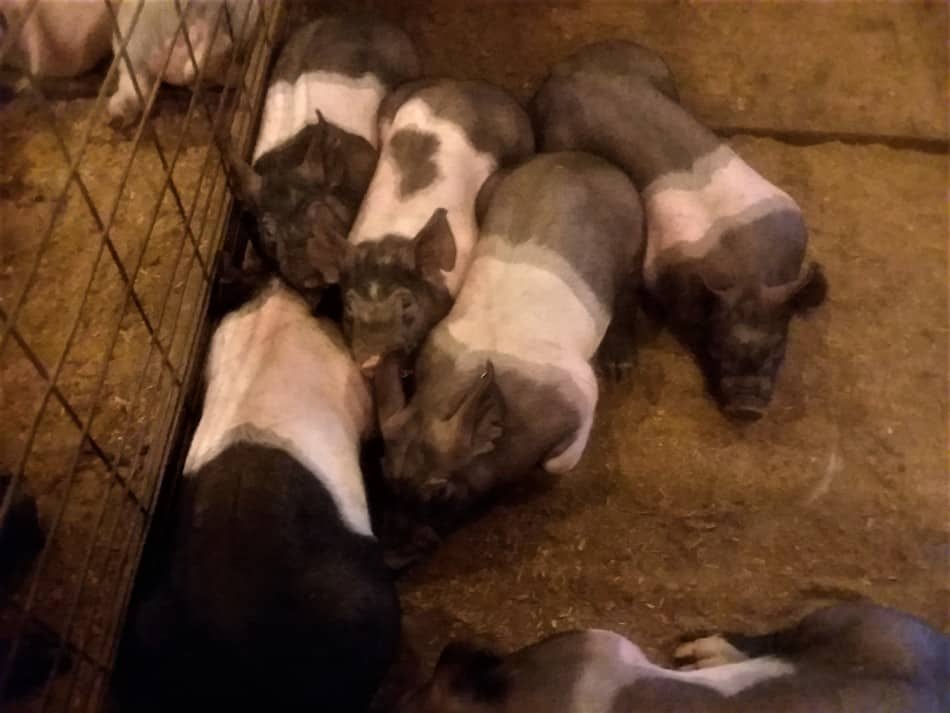
Time of the year affects pig’s feed consumption
The time of the year will affect how much feed the pigs eat.
On hot days feed consumption per day will go down, at least until it cools down at night.
During the cold parts of the year, the pig will need to eat more feed to grow than normal.
Why? Normally, part of the feed will be used by the pig’s body for maintenance needs (as always) and part will be used for growth.
When maintenance needs go up, like keeping the pig warm on frigid days, more of the feed eaten needs to be used for maintenance, leaving less for growth.
Make sure your pigs have all they can eat in the cold. If they have free access to feed, as their body uses more feed to stay warm, they are still growing.
Cut them short on the feed and they will automatically grow slower until the weather changes or they break out and find more to eat!
Raise Happy, Healthy Pigs goes over the specifics your pigs need to be happy and grow their best.
Amount of exercise affects your pig’s eating
Pigs that have a lot of room to run around will take more feed to get to finishing weight than pigs that have a smaller area.
Why? Just like any other animal, spending energy running around means less energy for growth.
Genetics of the pig determine growth
Not all pig breeds will finish the same. That is the point of different breeds, they perform differently. This isn’t good or bad, it just is.
Generally, a chunkier built pig will finish faster than a longer, leaner built pig. Also, the more unusual breeds/rare breeds are going to take longer to finish than a more common farm pig.
Wondering about which breed of feeder pig to get (and how much it really matters)? Check out my article Choosing The Best Pig Breed For Meat for the full scoop.
Total feed your pigs need is all about rate of gain
Rate of gain means the amount of feed needed per pound of body weight gained. Usually this is written as a ratio, like 3 to 1.
3 to 1 means 3 pounds of feed needed for every 1 pound of gain.
3-3.5 to 1 is pretty normal for commercial type feeder pigs up until they reach 250-260 pounds.
Once the pigs are over 250-260 the feed to gain ratio goes up to more like 5 to 1. Those last 40 or so pounds of gain to get your pigs up to 300+ pounds of weight take a lot of feed!
Feed wasted increases amount of pig feed you buy
If your feeder allows the pigs to tip it or play in it, you will have quite a bit of feed wasted. Sadly, you still paid for that feed but the pigs didn’t eat it.
Eliminating absolutely all feed waste is unlikely. Reducing it down to a reasonable level can be done.
If you are using a bulk feeder, keep it full. If the feeder attaches to the side of the pen, check daily to make sure it is still secure.
If it is a free standing feeder, keep it full. The weight of the feed will make it stay upright. If not, a quick, not so great fix would be to tether it to the side or corner of the pen.
The real problem here is that your feeder is too small for your pigs.
Feeding parasites increases the amount of feed you buy
Pigs that are supporting a substantial load of internal parasites will need more feed, sometimes a whole lot more feed, to get the same amount of growth as a pig with little to no parasite burden.
The easy way to work around this is to get dewormed feeder pigs. This seems to be especially important if your feeder pigs had access to dirt before you bought them.
While you can deworm the pigs yourself, it is a ton easier to buy feeders that were dewormed before you buy them!
To be clear, you do not have to deworm your pigs. But…
Once you realize they need dewormed, you have already lost a noticeable amount of growth and wasted a good amount of your time and money.
Finishing a pig is growing it to market size and weight
Finishing a pig just means growing it to market hog butchering weight and condition.
Both body size and fat covering are part of the term finished. A finished pig will be well grown for it’s frame and have a good fat covering.
Most people would get a few feeder pigs and raise them to finishing weight, around 260 pounds and 5.5-6 months of age.
You would be finishing the pig during the last part of it’s growth to butchering condition.
How can you tell if a pig is finished?
Consider the outline of a feeder pig. You can see they have a longer, leaner look to them than a finished hog, even with the chunkier body type feeder pigs.
A market hog that still looks athletic (long and lean) is not finished, it needs more fat.
On the other hand: A market hog that is sloppy fat is over finished. It was at the ideal body condition previously and just kept packing on the fat since then.
A finished hog looks like a blocky rectangle on legs.
It should be flat across the back (or even have the spine sit a bit lower than the back if you want more fat covering) and wide across the hams and chest.
Look at the jowls (where the jaw meats the neck) a finished pig will have an easy to see double chin.
The finish on a pig gives you flavorful, succulent pork
The reason finish (fat covering) is so important in pigs is flavor and juiciness of the pork. You want your pigs to have marbling, just like beef people talk about.
Fat is flavor, the finish on your pigs shows you that the pork will be great!
What do you feed to finish a pig?
All you need to finish a pig is time and the appropriate care: including feed, water, shelter and something to keep them busy like bedding to spread around or dirt to root up.
Feed you will need for your pigs
The feed part is easy, just go to your local farm store and get what they have in stock. Read the labels, there should be a few options.
The choice of feed will be based on the weight of your pigs, so you need to have an idea of how much they weigh before you go to buy feed.
If you are unsure about the weight of your pigs, or they are at that in-between weight, get the feed for the smaller sized pigs and go with the feed for larger pigs next time.
The only thing that really changes between the different feed mixes is protein levels in the feed, with younger pigs getting higher protein.
| Weight of pig | % protein needed |
| under 50 pounds | 21% |
| 50-80 pounds | 16% |
| 80-160 pounds | 14% |
| 160+ pounds | 12.6% |
Don’t sweat the choices here, get something close and you’ll be fine. You never need to switch feed formulations, if you don’t want to.
You can feed the higher percentage feeds for the entire time you have the pigs, but it will save you some money to switch to a lower protein level when your pig’s growth allows it.
If you are close to an actual feed mill that grinds feed for farmers, go there. You can get the same feed in 100 bulk bags for about half of the cost of the brand name 50 pound bags of feed.
Need more details? Click here for my article on what to feed your pigs.
Water is more important to your pigs than you think
Of course, the pigs need water, that’s not news. What may be overlooked, however, is that limiting water limits feed intake.
That’s a biggie, since limited feed intake equals limited growth!
Your pig must have all day access to plenty of water. If you give them water and come back in a few hours and the water is gone, they don’t have enough water.
Get a bigger waterer or if you are watering them by hand using pans, get more pans or just fill them more frequently.
If you have more than a few pigs, the carrying water they need every day will get to be a chore you really don’t like doing. Set up a barrel waterer and save yourself the carrying.
How long to finish a feeder pig?
Once again, this depends upon how big the feeder pig is when you first purchased it, but a good guess is 4 months.
That will make the feeder pig 5.5-6 months old at finishing weight.
Some pigs will take a bit longer, this varies with genetics and how you are raising the pigs.
Pigs with tons of space to run around in, like pastured pigs, will take longer to finish than pigs raised in a large pen.
How much feed does the pig eat per day?
Well, if you do the math keeping the pig for 4 months and it eating 650 pounds of feed (I picked the middle of the 600-700 pounds listed above) you’ll get 5.42 pounds of feed per pig per day.
4 months=120 days 650 pounds of feed divided by 120=5.42 pounds/day
That is a nice average to help you think about what your pigs will need, but it is not anything more than an average.
I’m sure there is a point in time when your pigs will actually eat 5.42 pounds of feed per day. But only for a few weeks at most.
What is really going to happen is the smaller pigs will eat less per day and the pigs that are nearly finished will be sucking down a bunch of feed per day.
What is the best feed for my pigs?
The best feed for your pigs is a complete ground feed you purchase from feed mill or feed store.
The Best Feed For Pigs goes into more detail on specifics of you pig’s feed ration.
Using a complete feed at the appropriate percent protein, you know that the pigs are getting all of the nutrients they need so they can grow well for you.
Since you are a beginner, start with a premixed feed (one that is already bagged for you).
Once you get some experience you can branch out to other feeds or even mix your own. If you want to supplement their diet with different foods to add interest to their diet, go for it.
As long as they are nature produced foods, so hay or vegetables, like cabbage-yes; candy or fast food left overs-no.
I like to give my pigs something interesting to poke around at, like edible weeds in the growing season or some hay and an occasional shovelful or two of dirt (yes, dirt) if they are in a pen, to keep them happy.

